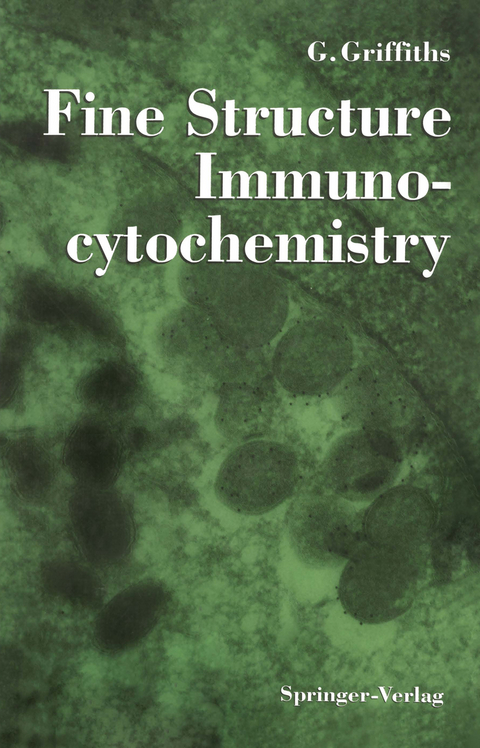
Fine Structure Immunocytochemistry
Springer Berlin (Verlag)
978-3-642-77097-5 (ISBN)
1 Introduction to Immunocytochemistry and Historical Background.- 1.1 Approaches to Immunocytochemistry.- 1.2 Criteria for an Electron-Microscopic Immunocytochemical Technique.- 1.3 Problems with the Pre-Embedding Techniques.- References.- 2 Fine Structure Preservation.- 2.1 Introduction.- 2.2 Fine-Structure Evaluation in Practice.- 2.3 Summary.- References.- 3 Fixation for Fine Structure Preservation and Immunocytochemistry.- 3.1 Fine Structure Preservation.- 3.2 Factors Affecting the Quality of Fixation for Fine Structure Preservation.- 3.3 Fixation Artefacts.- 3.4 Effect of Fixatives on Enzyme Activity.- 3.5 Fixation for Immunocytochemistry.- 3.6 A Concluding Remark.- References.- 4 Embedding Media for Section Immunocytochemistry.- 4.1 Resin-Free Sections - Temporary Embedement.- 4.2 Permanent Embedding Media.- 4.3 Freeze Substitution.- References.- Chapters 5 Cryo and Replica Techniques for Immunolabelling.- 5.1 Cryo Sectioning Techniques.- 5.2 Freeze-Fracture and Replica Labelling Methods.- 5.3 Other Replica Techniques for Labelling.- References.- 6 Elementary Immunology.- 6.1 Basic Immunology.- 6.2 The Structure of Antibodies.- 6.3 The Biological Functions of Immunoglobulins.- 6.4. The Nature of Antigenicity.- 6.5 Practical Aspects of Immunology.- 6.6 Affinity Purification.- 6.7 Characterization of Antibodies.- 6.8 Precipitin Techniques.- 6.9 Immunoblotting.- 6.10 Immunoprecipitation.- 6.11 Immunoassay.- References.- 7 Labelling Reactions for Immunocytochemistry.- 7.1 Historical Perspectives.- 7.2 Labelling in Practice.- 7.3 Approaches for Single Labelling.- 7.4 Approaches for Double Labelling.- References.- 8 Particulate Markers for Immunoelectron Microscopy.- 8.1 Colloidal Gold.- Appendix. Silver Enhancement Procedure.- References.- 9 Non-ImmunologicalHigh-Affinity Interactions Used for Labelling.- 9.1 Lectins.- 9.2 Protein A.- 9.3 Protein G.- 9.4 Avidin-Biotin Interactions.- 9.5 Miscellaneous Labelling Approaches Relying on Non-Immunological High Affinity Interactions.- 9.6 In-Situ Hybridization.- References.- 10 Preembedding Immuno-Labelling.- 10.1 Permeabilization.- 10.2 Markers for Preembedding Labelling.- 10.3 Preembedding Studies of the Nucleus.- 10.4 Preembedding Labelling for Studies of the Nervous System.- 10.5 The Use of Dinitrophenol IgG Conjugates.- 10.6 Agarose Gel Method for Preembedding.- References.- 11 Quantitative Aspects of Immunocytochemistry.- 11.1 General Comments.- 11.2 Basic Stereology.- 11.3 Estimation of Volume Density and Surface Density in Practice.- 11.4 Estimation of Volume of Reference Space.- 11.5 Stereological Sampling in Practice.- 11.6 Quantitation in Immunocytochemistry.- 11.7 Approaches for Quantitation Ignoring Labelling Efficiency.- 11.8 Absolute Quantitation Making Assumptions About Labelling Efficiency.- 11.9 Negation of the Labelling Efficiency Factor: The Matrix Gel Method for Quantitating Souble Antigens Which Are Available in Pure Form.- 11.10 Quantitative Model System Developed for Small Molecular Weight Neurotransmitters.- 11.11 Sensitivity of Labelling: Limits of Detection.- 11.12 Steric Hindrance.- 11.13 Amplification of Gold Labelling and Quantitation.- 11.14 Signal-to-Noise Ratio and the Concentration of Antigen: Those Few Gold Particles!.- References.- 12 An Overview of Techniques for Labelling at the EM Level.
"a wealth of solid, well-referenced information...The more experienced user will find this is an essential reference text" Australian Journal of Medical Science
"a wealth of solid, well-referenced information...The more experienced user will find this is an essential reference text" Australian Journal of Medical Science
| Erscheint lt. Verlag | 6.12.2011 |
|---|---|
| Co-Autor | B. Burke, J. Lucocq |
| Zusatzinfo | XXI, 459 p. |
| Verlagsort | Berlin |
| Sprache | englisch |
| Maße | 155 x 235 mm |
| Gewicht | 726 g |
| Themenwelt | Naturwissenschaften ► Biologie ► Biochemie |
| Naturwissenschaften ► Biologie ► Mikrobiologie / Immunologie | |
| Naturwissenschaften ► Biologie ► Zellbiologie | |
| Schlagworte | Antibody • Biology • Chemistry • cryotechniques • electron microscopy • Elektronenmikroskopie • Enzyme • enzymes • Ferritin • glycoprotein • Immunocytochemie • immunolabelling • Membrane • Microscopy • Molecular Biology • organells • Präparation • Preparation • Protein • proteins • receptor • tissue • Zellorganellen |
| ISBN-10 | 3-642-77097-5 / 3642770975 |
| ISBN-13 | 978-3-642-77097-5 / 9783642770975 |
| Zustand | Neuware |
| Haben Sie eine Frage zum Produkt? |
aus dem Bereich


